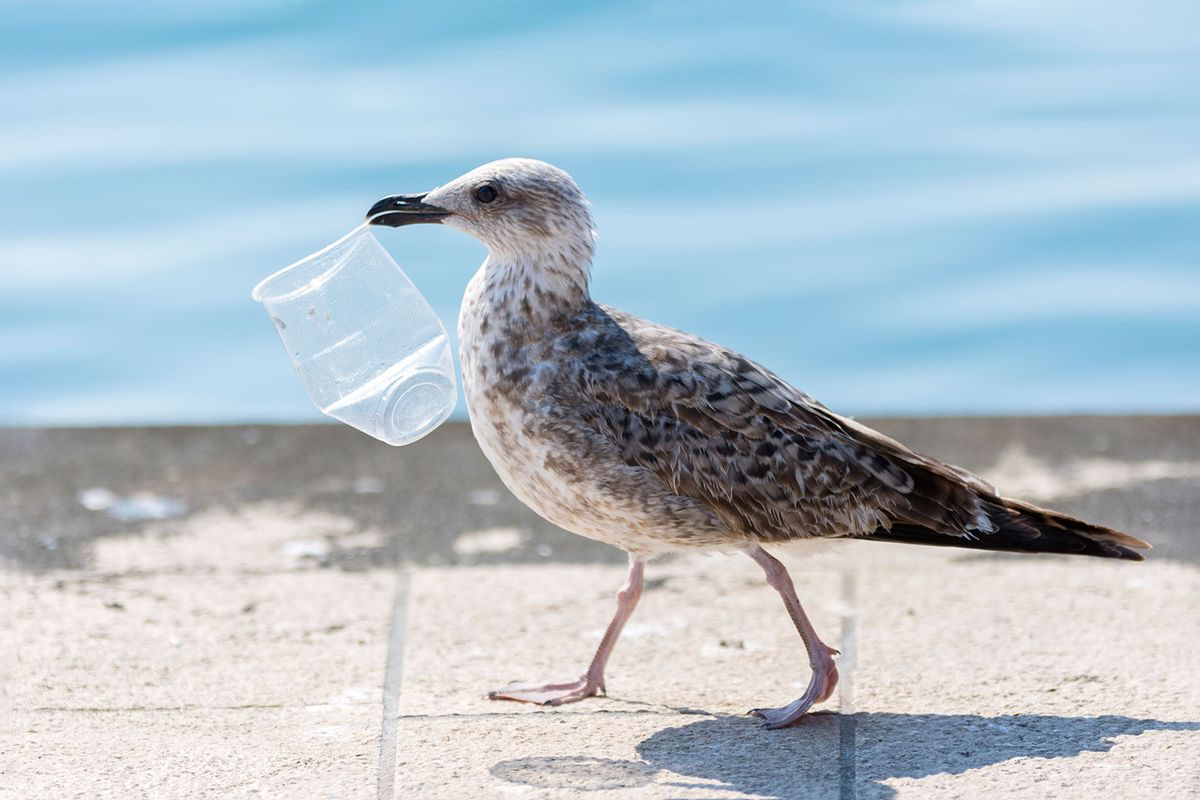Humans produce mountains of plastic every year, upwards of 400 million metric tons annually, with much of it clogging our oceans, where unwitting animals gobble it up. New research illuminates just how damaging this can be to seabirds, including scarring, inflammation and organ failure. In some cases, it seems to be fatal. Researchers have dubbed this new plastic-induced disease "plasticosis."
"While these birds can look healthy on the outside, they're not doing well on the inside."
In a new, first of its kind study in the Journal of Hazardous Materials, a team of conservation biologists analyzed the digestive tracts of 30 freshly dead seabirds called flesh-footed shearwaters (Ardenna carneipes). These waterfowl are among the world's most plastic-contaminated species, according to a previous study by some of the same authors reporting that 90 percent of autopsied flesh-footed shearwaters had ingested plastic.
"While these birds can look healthy on the outside, they're not doing well on the inside," Dr. Alex Bond, who co-authored the study and is principal curator of birds at the Natural History Museum in London, said in a statement. "This study is the first time that stomach tissue has been investigated in this way and shows that plastic consumption can cause serious damage to these birds' digestive system."
In the recent study, Bond and colleagues collected 30 recently deceased shearwaters from Lord Howe Island, Australia. They dissected a glandular organ in the birds called a proventriculus, which functions essentially like the first part of the stomach of other animals. Before anything enters a bird's gizzard, an organ for grinding up food, the proventriculus secretes digestive enzymes and hydrochloric acid to break down meals.
The researchers collected tissue samples and scrutinized the level of abnormalities. They also counted the amount of plastic in the birds digestive system, weighing it and organizing it by size. They found that the level of plastic was correlated with greater scarring and inflammation, which is likely to severely impact the health and longevity of the any animal that eats it, including humans.
To a bird, fish or other creature, plastic may resemble food and they may swallow it, not knowing any better. But depending on their size and shape, plastic chunks can shred the insides of animal digestive tracts. Over time, the resulting scarring adds up, causing a disease called fibrosis, which is named because it results from excessive collagen fibers. It can choke organs, obstructing blood flow and causing them to break down. This damage is seemingly irreversible.
"It is likely that plastic induces a swathe of sub-lethal effects which we were not able to capture in this study, such as introducing toxic chemical pollutants, changing gene expression, disrupting metabolism, or causing tissue dysfunction."
While large shards of plastic can lacerate organ walls, the smaller particles, known as microplastics, can be just as deleterious. Measuring somewhere between 1 and 5 millimeters small, or about 10 to 50 times the width of a human hair, microplastics can more easily enter the bloodstream and accumulate in tissues and organs. They can also break down even further into nanoplastics, which can slip across the membranes of cells, wreaking havoc on their internal functions.
"We identified significant evidence for widespread plastic-related scar tissue formation in the proventriculus of wild seabirds," the authors wrote in what is likely the first study to thoroughly document plastic-induced fibrosis in wild organisms. They call this disease plasticosis, which is comparable to asbestosis and silicosis, two diseases also caused by inhaling foreign particles (asbestos and crystalline silica dust respectively.)
Want more health and science stories in your inbox? Subscribe to Salon's weekly newsletter The Vulgar Scientist.
"It is likely that plastic induces a swathe of sub-lethal effects which we were not able to capture in this study, such as introducing toxic chemical pollutants, changing gene expression, disrupting metabolism, or causing tissue dysfunction," the authors added.
Flesh-footed shearwaters naturally swallow pumice, a lightweight and porous volcanic rock, that helps the birds digest their food. But the level of pumice in the shearwaters' digestive tracts was not correlated with more scarring. This makes sense — the birds evolved to swallow rocks, not plastic, so if pumice was causing damage, it would have affected the birds' health long ago.
"This highlights the unique pathological properties of plastics and raises concerns for other species impacted by plastic ingestion," the authors wrote. It is yet another indicator that we are in the Anthropocene, a proposed geological epoch bounded by human activities which have had a significant impact on the Earth's ecosystems. Plastic, with its massive global footprint, seems to fit the bill and animals (and us) are paying the price.
While shearwaters are the only animals currently known to have plasticosis, given the ubiquity of humanity's favorite polymers, it's very likely that other creatures have developed similar diseases. Humans may not be immune, either. While most people (generally) don't eat plastic on purpose, microplastics have been detected in everything from table salt to beer and even human breast milk and blood.
There's not a lot of research describing how damaging, exactly, all this plastic exposure can be. For at least a decade, some experts have called to define plastic as a hazardous waste, due to its widespread health effects and toxic byproducts. But part of the reason we don't have good data on this is because laboratory studies usually incorporate unused, "virgin" plastics such as spherical polystyrene, which is used to make Styrofoam.
"This does not accurately reflect weathered plastics found in the environment, which are conversely a heterogeneous mix of polymers of different shapes, sizes, and stages of fragmentation," the authors wrote, emphasizing how their research eschews this limitation. We clearly need better studies using wild animals and the direct effects plastic can have on them, as plasticosis may not be the only negative impact plastic is having on living organisms.



Shares